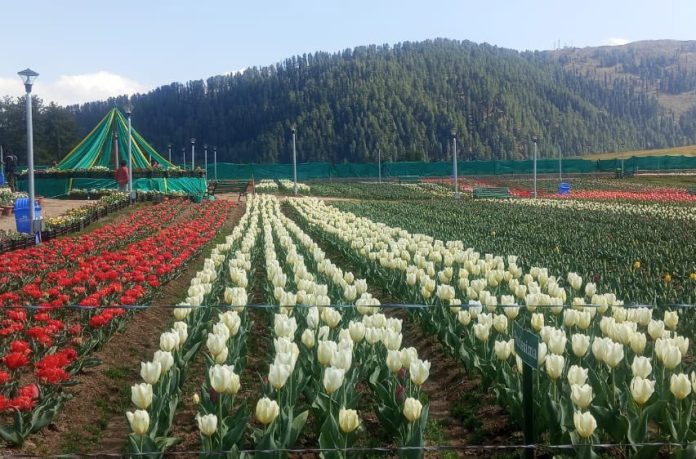Nestled against the picturesque backdrop of the Zabarwan hills, overlooking the iconic Dal Lake, Asia’s largest Tulip Garden stands as a testament to the enduring allure of nature’s most enchanting blooms. This season, the garden has witnessed an unprecedented surge in visitors, attracting admirers from across the nation and around the globe. Since opening its gates to visitors on March 23, the Tulip Garden has become a magnet for tourists, drawing in over 4.2 lakh people, including nearly 3,000 foreign travellers. This influx of visitors has surpassed all previous records, underscoring the garden’s growing prominence as a must-see destination on the global tourism map. With a staggering display of 1.7 million tulips, comprising 68 different varieties, the garden has captured the hearts and minds of all who have had the privilege of wandering through its meticulously manicured pathways. Each petal, each bloom, is a testament to the meticulous care and dedication of the Department of Floriculture, who have worked tirelessly to ensure that the garden remains a feast for the senses.
Tulips have a brief life span of around 25-30 days, but despite their fleeting nature, these blooms continue to draw visitors in droves, eager to witness the spectacle before it fades away. The anticipation surrounding the announcement of the culmination dates adds to the garden’s mystique, leaving visitors eager to savour every last moment of its splendour. One cannot underestimate the significance of the Tulip Garden as a cultural and economic asset for the region. Not only does it serve as a showcase for the natural beauty of Kashmir, but it also plays a pivotal role in bolstering tourism and generating revenue for the local economy. The influx of foreign tourists, in particular, underscores the garden’s global appeal, with dedicated facilities and services catering to their needs. The continuous breaking of visitor records year after year is a testament to the enduring legacy of the Tulip Garden. Surpassing last year’s record of 3.7 lakh visitors, this year sets a new benchmark, further solidifying the garden’s status as a premier tourist attraction.
Its ability to consistently draw in crowds speaks volumes about its timeless charm and universal appeal. Social media and the media have played a pivotal role in amplifying the garden’s international reputation, reaching audiences far and wide. The stunning visuals and glowing testimonials shared by visitors have served as powerful endorsements, enticing even more travellers to make the journey to witness the beauty of the Tulip Garden firsthand. In today’s interconnected world, where information travels at the speed of light, the digital spotlight on the garden has undoubtedly contributed to its surge in popularity.
The Tulip Garden, beyond its aesthetic appeal, serves as a symbol of hope and resilience for the people of Kashmir. In a region overshadowed for a long by conflict and turmoil, it stands as a beacon of peace and tranquillity, offering a sanctuary where visitors are now reconnecting with the beauty of nature without any fear or pressure. It’s not just about the numbers; it’s about the lasting impact on the locals, fostering economic growth, and promoting cultural exchange.
This garden is a shining example of the transformative power of nature and tourism. Its breathtaking beauty transcends borders and language barriers, bringing people together in awe and admiration. The overwhelming tourist response to this garden underscores how a singular tourism initiative can catalyse transformation within a region. It serves as a compelling example for the administration to pursue the development of distinct tourism projects tailored to the unique characteristics of various regions within the UT. The creation of such projects is of paramount importance to extend the duration of tourists’ stays in the UT. Jammu and Kashmir possess vast untapped tourism potential, necessitating the implementation of numerous similar ventures to fully harness the region’s tourism assets.


